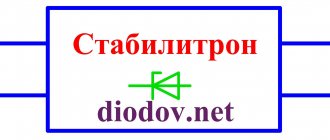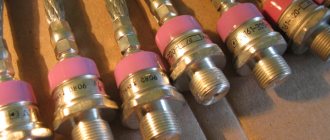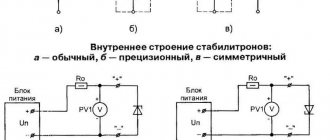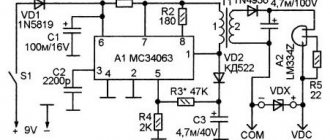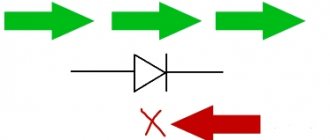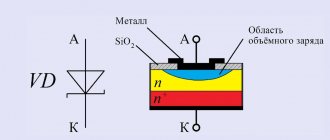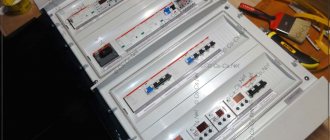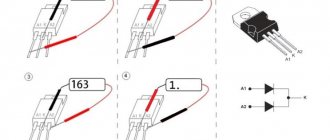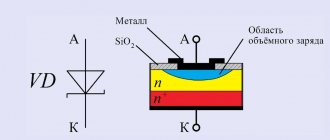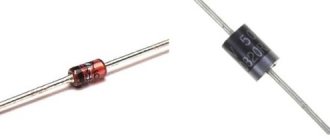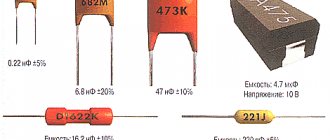Color coding of diodes in SOD-123 packages
Diodes in SOD-123 packages are coded with colored rings located on the cathode side. The brands of diodes corresponding to these colors are shown in the table.
| Stripe on the cathode | Device |
| Red | BA620, BB620 |
| Yellow | BA619, BB619 |
| Green | BA585 |
| Blue | BA582, 583, 584 |
| White | BA512, 515, BB515, 811 |
Definition of a diode and its types
A diode is an electronic part consisting of two electrodes. Depending on the polarity of the voltage, its conductivity changes. According to the current-voltage characteristic, the diode is nonlinear and asymmetrical. This distinguishes it from an incandescent lamp and a thermistor.
The diode consists of:
- vacuum glass, ceramic or metal flask
- cathode, creating electron emission
- anode for receiving electrical carriers
- heating filament
- germanium or silicon crystal
Based on their structure and properties, diodes are divided into:
- planar
- universal
- pulse
- rectifier
A separate category includes LEDs, photodiodes and thyristors.
There are electric vacuum and gas-filled diodes, discharge stabilizing devices and semiconductors. The latter type is most common in electrical engineering.
Color coding of diodes in SOD-80 packages
The SOD-80 body, also known as MELF, is a small glass cylinder with metal leads.
Examples of diode markings.
Marking 2Y4 to 75Y (E24 series) BZV49 1W silicon zener diode (2.4 – 75V) Marking C2V4 to C75 (E24 series) BZV55 500mW silicon zener diode (2.4 – 75V)
The cathode terminal is marked with a colored ring.
Marking of devices with colored rings.
| Cathode output | Device |
| Black | BAS32, BAS45, BAV105 LL4148, 50, 51,53, LL4448 BB241,BB249 |
| Black and Kochichnevy (Black Brown) | LL4148, LL914 |
| Black and orange (Black Orange) | LL4150, BB219 |
| Brown and green | LL300 |
| Brown and black | LL4448 |
| Red | BA682 |
| Red and orange | BA683 |
| Red and green | BA423L |
| Red and White | LL600 |
| Orange and Yellow | LL3595 |
| Yellow | BZV55,BZV80,BZV81 series zeners |
| Green | BAV105, BB240 |
| Green and black (Green Black) | BAV100 |
| Green and nomadic (Green Brown) | BAV101 |
| Green and red (Green Red) | BAV102 |
| Green and orange | BAV103 |
| Gray | BAS81, 82, 83, 85, 86 |
| White | BB219 |
| White and green (White Green) | BB215 |
Some SMD diodes in MiniMELF (SOD80 / DO213AA / LL34) or MELF (DO213AB / LL41) cylindrical packages are often marked with colored stripes (the first stripe closest to the edge is located at the cathode) in accordance with the table on the left.
Having a radio-electronic laboratory at home, you can make a variety of devices for electrical equipment or the devices themselves, which will allow you to significantly save on the purchase of equipment. An important element of many electrical circuits of devices is the zener diode.
Such an element (smd, smd) is a necessary part of many electrical circuits. Due to its wide range of applications, the zener diode has different markings. The markings applied to the body of such a diode provide detailed, but encrypted, information about this element. Our article today will help you understand what color markings are found on the housing (glass or not) of imported zener diodes.
Marking of foreign zener diodes
The designation of foreign zener diodes, as well as diodes, is carried out according to two popular standards JEDEC and PRO ELECTRON. Since everything is described in detail in the article on marking diodes, I see no point in repeating this information; I will only dwell on some of the features.
Marking of zener diodes in a glass case with flexible leads is carried out in a very clear way. Typically, numbers are applied to the body, separated by the Latin symbol “V”. For example, 4V7 indicates a stabilization voltage of 4.7 Volts; 9V1, respectively 9.1 V, etc.
The black ring on the body of glass zener diodes is the negative terminal (cathode).
Features of color marking of zener diodes.
When marking smd zener diodes, colored rings are used. Similar markings are also used for domestic zener diodes, but more on that below. In foreign SMD zener diodes, the color ring is applied from the cathode side. Information on decoding color rings can be found in the same article above on diode markings or in the reference manual on SMD component markings (to download it, you need to click on the green arrow, just above).
Some companies manufacture SMD zener diodes with three terminals, while one of them is not used. You can determine the excess one using a multimeter.
| Color marking of domestic zener diodes and stabilizers |
| Diode type | Mark at the cathode terminal | Mark at the anode terminal | Drawing |
| D814A1 | — | black wide ring | |
| D814B1 | — | black wide+black narrow ring | |
| D814V1 | — | black narrow ring | |
| D814G1 | — | yellow wide ring | |
| D814D1 | — | three narrow black rings | |
| D818A | black mark on the end of the case + white ring | — | |
| D818B | black mark on the end of the case + yellow ring | — | |
| D818V | black mark on the end of the case + blue ring | — | |
| D818G | black mark on the end of the case + green ring | — | |
| D818D | black mark on the end of the case + gray ring | — | |
| D818E | black mark on the end of the case + orange ring | — | |
| KS107A | gray mark on the end of the case + red ring | — | |
| KS126A | red wide+purple narrow+white narrow rings | — | |
| KS126B | orange strip + black narrow + white narrow ring | — | |
| KS126V | orange wide+orange wide+white narrow rings | — | |
| KS126G | orange wide+white narrow+white narrow rings | — | |
| KS126D | yellow wide+purple narrow+white narrow rings | — | |
| KS126E | green wide+blue narrow+white narrow rings | — | |
| KS126ZH | blue wide + red narrow + white narrow rings | — | |
| KS126I | blue wide+gray narrow+white narrow rings | — | |
| KS126K | purple narrow+green narrow+white narrow rings | — | |
| KS126L | gray wide+red narrow+white narrow rings | — | |
| KS126M | white wide+brown narrow+white narrow rings | — | |
| KS207A | brown wide+black narrow+black narrow rings | — | |
| KS207B | brown wide+brown narrow+black narrow rings | — | |
| KS207V | brown wide+red narrow+black narrow rings | — | |
| KS133A | blue ring | white ring | |
| 2С133А | white ring | black ring | |
| KS133G | orange mark on the end of the case | — | |
| KS139A | green ring | white ring | |
| 2С139А | green ring | black ring | |
| KS147A | gray or blue ring | white ring | |
| 2С147А | — | black ring | |
| KS147G | green mark on the end of the body | — | |
| KS156A | orange ring | white ring | |
| 2С156А | orange ring | black ring | |
| KS156G | red mark on the end of the body | — | |
| KS168A | red ring | white ring | |
| 2С168А | red ring | black ring | |
| KS175ZH | white ring | — | |
| KS182ZH | yellow ring | — | |
| KS191ZH | red ring | — | |
| KS210ZH | green ring | — | |
| KS211Zh | gray ring | — |
| Stabilizer type | Mark at the cathode terminals | Mark at the anode terminals | Drawing |
| KS212Zh | orange ring | — | |
| KS213Zh | black ring | — | |
| KS215Zh | white ring | black ring | |
| KS216ZH | yellow ring | black ring | |
| KS218Zh | red ring | black ring | |
| KS220Zh | green ring | black ring | |
| KS222Zh | gray ring | black ring | |
| KS224Zh | orange ring | black ring | |
| 2S175Zh | blue mark on the end of the case + white ring | — | |
| 2S182Zh | blue mark on the end of the body + yellow ring | — | |
| 2S191Zh | blue mark on the end of the case + red ring | — | |
| 2S210ZH | blue mark on the end of the case + green ring | — | |
| 2S211ZH | blue mark on the end of the case + gray ring | — | |
| 2S212ZH | blue mark on the end of the case + orange ring | — | |
| 2S213ZH | blue mark on the end of the case + black ring | — | |
| 2S215ZH | blue mark on the end of the case + white ring | black ring | |
| 2S216ZH | blue mark on the end of the body + yellow ring | black ring | |
| 2S218ZH | blue mark on the end of the case + red ring | black ring | |
| 2S220ZH | blue mark on the end of the case + green ring | black ring | |
| 2S222ZH | blue mark on the end of the case + gray ring | black ring | |
| 2S224ZH | blue mark on the end of the case + orange ring | black ring | |
| KS405A | gray mark on the end of the case + red ring | black ring | |
| KS406A | black mark on the end of the case + gray ring | white ring | |
| KS406B | black mark on the end of the case + white ring | orange ring | |
| KS407A | black mark on the end of the case + red ring | blue ring | |
| KS407B | black mark on the end of the case + red ring | orange ring | |
| KS407V | black mark on the end of the case + red ring | yellow ring | |
| KS407G | black mark on the end of the case + red ring | green ring | |
| KS407D | black mark on the end of the case + red ring | gray ring | |
| KS411A | white ring | black ring | |
| KS411B | blue ring | black ring | |
| KS508A | black mark on the end of the case + orange ring | green ring | |
| KS508B | black mark on the end of the case + yellow ring | white ring | |
| KS508V | black mark on the end of the case + red ring | green ring | |
| KS508G | black mark on the end of the case + blue ring | white ring | |
| KS508D | black mark on the end of the case + green ring | white ring | |
| KS510A | orange ring | green ring | |
| KS512A | yellow ring | green ring | |
| KS515A | white ring | green ring | |
| KS516A | green ring | black ring | |
| KS518A | blue ring | green ring | |
| KS522A | gray ring | green ring | |
| KS527A | black ring | green ring |
| How to check zener diode |
It is impossible to fully check it and say with 100% certainty that this zener diode is serviceable with a digital multimeter. Of course, it can be checked in the same way as a diode, but you can mistakenly consider the working zener diode to be damaged. Is this possible? Let's conduct a small practical experiment, take any zener diode with a small stabilization voltage, for example 2.4 volts. And we connect it to a digital multimeter, and it rings in both directions. But the trick is that there is about 5 volts on the digital multimeter probes, and therefore it simply breaks through in the opposite direction. Therefore, you should not check zener diodes with low stabilization voltage with digital multimeters; it is better to use an old analog tester, and if you don’t have one, you can assemble a small circuit.
What is this element of electrical circuits?
Before we begin to consider the question of what color markings exist for such elements, we need to understand what it is all about.
Volt-ampere characteristic of a zener diode
A zener diode is a semiconductor diode, which is designed to stabilize the DC voltage across the load in an electrical circuit. Most often, such a diode is used to stabilize voltage in various power supplies. This diode (smd) has a section with a reverse branch of the current-voltage characteristic, which is observed in the region of electrical breakdown.
Having such an area, the zener diode in a situation where the parameter of the current flowing through the diode changes from IST.MIN to IST.MAX, practically no changes in the voltage indicator are observed. This effect is used to stabilize voltage. In a situation where the RH load is connected in parallel to the SMD, then the diode voltage will remain constant, and within the specified limits of change in the current flowing through the zener diode.
Note! Zener diode (smd) is capable of stabilizing voltages above 3.3 V.
In addition to SMD, there are also zeners, which are turned on when switched on directly. They are used in situations where there is a need to stabilize the voltage in a certain range. A conventional diode can be used when it is necessary to stabilize the voltage in the range from 0.3 to 0.5 V. The region of their forward bias is observed when the voltage drops to 0.7 - 2v. Moreover, it practically does not depend on the current strength. In their work, stabistors use the direct branch of the current-voltage characteristic. They should also be turned on when connected directly. Although this will not be the best solution, since a zener diode in such a situation will still be more effective. Stabistors, like SMD, are often made from silicon. Zener diodes are labeled according to their main characteristics. This marking looks like this:
- UST. This marking indicates the rated voltage for stabilization;
- ΔUST. Indicates the deviation of the voltage indicator of the rated stabilization voltage;
- IST. Indicates the current that flows through the diode at the rated stabilization voltage;
- IST.MIN - the minimum value of the current that flows through the zener diode. At this value, such an SMD diode will have a voltage in the range UST ± ΔUST;
- IST.MAX. Indicates the maximum permissible amount of current that can flow through the zener diode.
Analogs
The table shows foreign and domestic models of diodes that are as close as possible in characteristics to the D9 diode.
| Type | Vobr max., V | Ipr max., mA | Ipr imp max., mA | T, °C | |||
| Original | |||||||
| D9 | Min. | Max. | Min. | Max. | Min. | Max. | -60…+70°C |
| 10 | 100 | 15 | 40 | 48 | 125 | ||
| Foreign analogues | |||||||
| 1N34A | 20 | 200 | 500 | -55…+75°C | |||
| 1N87 | 25-30 | 30-50 | — | — | |||
| AA137 | 40 | 500 | — | -60…+85°C | |||
| Domestic analogue | |||||||
| D 2 | Min. | Max. | Min. | Max. | Min. | Max. | -60…+70°C |
| 10 | 150 | 8 | 25 | 48 | — | ||
These diodes have few analogues, but due to the wide model range, which includes 10 modifications, it is possible to select a replacement for a specific diode using a different model.
Note: the data in the table is taken from the manufacturer's datasheet.
Designations for the operation of an electrical circuit element
Schematic designation of a zener diode
Since the zener diode is a special diode, its designation is no different from them. Schematically, smd is designated as follows:
A zener diode, like a diode, has a cathode and anode part. Because of this, there is direct and reverse inclusion of this element.
At first glance, the inclusion of such a diode is incorrect, because it should be connected “the other way around”. In a situation where reverse voltage is applied to the SMD, the phenomenon of “breakdown” is observed. As a result, the voltage between its terminals remains unchanged. Therefore, it must be connected in series to a resistor in order to limit the current passing through it, which will ensure that the “excess” voltage from the rectifier drops.
Note! Each diode designed to stabilize voltage has its own “breakdown” (stabilization) voltage and also has its own operating current.
Due to the fact that each zener diode has such characteristics, it is possible to calculate the value of the resistor that will be connected in series with it. For imported zener diodes, their stabilization voltage is presented in the form of markings on the body (glass or not). The designation of such an smd diode always begins with BZY... or BZX..., and their breakdown (stabilization) voltage is marked V. For example, the designation 3V9 stands for 3.9 volts.
Note! The minimum voltage for stabilization of such elements is 2 V.
The principle of operation of a zener diode
Let's consider the principle of operation of a zener diode using the example of its connection circuit and current-voltage characteristic. To perform its main function, the zener diode VD is connected in series with a resistor Rb and together they are connected to a source of unstabilized input voltage Uin. The already stabilized output voltage Uout is removed only from pins 2, 3 VD. Therefore, the load Rн is connected to the corresponding points 2 and 3. As can be seen from the diagram, VD and Rb form a voltage divider. Only the resistance of the zener diode does not have a constant value and is called dynamic, since it depends on the amount of electric current flowing through the semiconductor device.
The voltage Uin supplied to the zener diode from the resistors must be at least a couple of volts higher than the output voltage Uout, otherwise the semiconductor device VD will not open and will not be able to perform its main function.
Let's say that at some arbitrary point in time at outputs 1 and 3 the value of Uin began to increase. The following processes will begin to occur in the circuit. As the voltage increases, according to Ohm's law, the current will begin to increase, let's call it the input current Iin. As the current increases, the voltage drop across the resistor Rb will increase, and at VD it will remain unchanged (this will be explained further in the characteristic), therefore Uout will remain at the same level. Consequently, the increase in input voltage will drop or be extinguished by resistor Rb. Therefore, Rb is called damping or ballast.
Now, let’s say the load has changed, for example, the resistance Rн has decreased, and the current In will increase accordingly. In this case, the current flowing through the zener diode Ist will decrease, and Iin will remain virtually unchanged.
Operating principle of stabilization diodes
Despite the fact that the SMD is similar to a diode, it is essentially a different element of the electrical circuit. Of course, it can serve as a rectifier, but is usually used to stabilize the voltage. This element is capable of maintaining a constant voltage in a DC circuit. This principle of operation is used in power supply of various radio equipment.
Zener diode and diode
Externally, SMD is very similar to a standard semiconductor. The similarity remains in the design features. But when designating such a radio element, unlike a diode, the letter G is placed on the diagram. If you do not delve into mathematical calculations and physical phenomena, then the operating principle of smd will be quite clear.
Note! When turning on such an SMD diode, you must observe reverse polarity. This means that the connection is made with the anode to the minus.
Passing through this element, a small voltage in the circuit provokes a strong current. As the reverse voltage increases, the current also increases, only in this case its growth will be observed weakly. When you reach the mark, it can be anything. It all depends on the type of device. When the mark is reached, a “breakdown” occurs. After the “breakdown” has occurred, a large reverse current begins to flow through the smd. It is at this moment that the operation of this element begins until its permissible limit is exceeded.
Application area
The D9 series of diodes is used in circuits for converting alternating voltage, the frequency of which does not exceed 100 kHz. Also, in addition to the conversion function, diodes can protect the circuit from incorrect polarity or, in the event of breakdown of any element, from current leakage. This allows these diodes to be used in a wide variety of radio engineering or household electrical appliances, such as:
- sound amplifiers;
- switches;
- Power supplies;
- and much more.
How to distinguish a stabilization diode from a conventional semiconductor
Very often people wonder how they can distinguish a zener diode from a standard semiconductor, because, as we found out earlier, both of these elements have almost identical symbols on the electrical circuit and can perform similar functions. The easiest way to distinguish a stabilization semiconductor from a regular one is to use a multimeter attachment circuit. With its help, you can not only distinguish both elements from each other, but also identify the stabilization voltage, which is characteristic of a given SMD (if it, of course, does not exceed 35V). The multimeter attachment circuit is a DC-DC converter, in which there is galvanic isolation between the input and output. This diagram looks like this:
Multimeter attachment circuit
In it, a generator with pulse-width modulation is implemented on a special microcircuit MC34063, and to create galvanic isolation between the measuring part of the circuit and the power source, the control voltage should be removed from the primary winding of the transformer. For this purpose there is a rectifier on VD2. In this case, the value for the output voltage or stabilization current is set by selecting resistor R3. A voltage of approximately 40V is released at capacitor C4. In this case, the tested SMD VDX and the stabilizer for current A2 will form a parametric stabilizer. The multimeter, which is connected to terminals X1 and X2, will measure the voltage at this zener diode. When connecting the cathode to the “-” and the anode to the “+” of the diode, as well as to the asymmetrical SMD of the multimeter, the latter will show a slight voltage. If you connect in reverse polarity (as in the diagram), then in a situation with a conventional semiconductor, the device will register a voltage of about 40V.
Note! For symmetrical SMD, the breakdown voltage will appear in the presence of any connection polarity.
Here the T1 transformer will be wound on a torus-shaped ferrite core with an outer diameter of 23 mm. Such winding 1 will contain 20 turns, and the second winding will contain 35 turns of PEV 0.43 wire. In this case, it is important to lay the turn to the turn when winding. It should be remembered that the primary winding goes on one part of the ring, and the second on the other. When setting up the device, connect a resistor instead of smd VDX. This resistor should have a value of 10 kOhm. And resistance R3 needs to be selected in order to achieve a voltage of 40V on capacitor C4. This is how you can find out whether you have a zener diode or a regular diode.
Main conclusions
Knowledge of the markings of SMD diodes and other components will help when performing repair work, identifying analogues or options for replacing parts. To obtain detailed information about the parameters of elements, you must use the following sources:
- directory of SMD component codes;
- datasheet (mainly for transistors);
- deciphering the code for resistors or chokes.
The number of SMD diodes and other parts is large. Many manufacturers develop their own marking system, which is in no way correlated with other designations, which introduces significant confusion into the process of identifying and replacing problematic elements. Therefore, it is important to have reference books and complete blocks of information on the parameters of diodes or other parts from different companies on hand.
Details about the color coding of the stabilizing diode
Any diode (zener diode, etc.) contains a special marking on its case, which reflects what material was used to manufacture each specific semiconductor. Such marking may look like this:
In addition, the marking reflects the electrical properties and purpose of the device. Usually a number is responsible for this. The letter, in turn, reflects the corresponding type of device. In addition, the marking contains the date of manufacture and the symbol of the product. Integral type SMDs often contain full markings. In such a situation, there is a conditional code on the product body that indicates the type of microcircuit. An example of decoding the code markings for microcircuits applied to the housing is shown in the figure:
Marking of zener diodes
Markings are applied to the zener diode housing in the form of numbers and letters (or letters). There are fundamentally two different types of markings. The zener diode in a glass case has the usual markings for us, directly indicating the rated stabilization voltage. The numbers can be separated by the letter V, which acts as a decimal point. For example, 5V1 means 5.1 V.
A less clear way of marking consists of four numbers and a letter at the end. If you are not an experienced radio amateur, then you can’t do without a datasheet. For example, let's decipher the parameters of the reference diode of the 1N5349B series. We are most interested in the first column, which shows the rated voltage of 12 V. The second column is the rated current value - 100 mA.
The cathode of a zener diode of any type is indicated by a black or blue ring, which is applied to the body from the side of the corresponding terminal.
SMD diode polarity
Capacitor markings
Radio amateurs sometimes have difficulty correctly determining the poles of an SMD element.
Polarity designation options:
- Often there is a triangle, the vertex of which points to the cathode. Simplified, the same symbol is represented by a horizontal line with a protrusion facing the cathode;
- If only one bar is designated, it is on the negative pole;
- PLLC devices (white plastic coated) have a slot on the cathode side.
Determining the polarity of an SMD diode
Of the SMD diodes shown in the figure, the one on the far right does not fit any description. In this case, only viewing in the data sheet helps.
Diode junction area
The right layer of the diode (p) has hole conductivity, and the left one (n) conducts negative electrons through itself. When the holes on the right side change their position, a current is generated. When layers of different conductivities touch each other, holes move to the left side of the diode, and electrons move to the right. A positive charge is formed in the border zone on the left side, and negative charges are formed on the border on the right side.
Based on the size of the junction, diodes are divided into:
- planar;
- point;
- microalloy
The first type is distinguished by the shape of the plate, in which both zones are endowed with impurity conductivity. The latter have a small area for the movement of weak current. The third type combines single crystals.
Planar diodes
Point diodes
Microalloy diode
An electric field is formed between the boundaries of the p and n regions. It is a barrier of current carriers with a region of minimum charge concentration. When the direction of the electric field outside changes, the barriers change and the resistance of the electric currents increases. In this case, the transitions are endowed with gate characteristics.
Additional markings for glass models
Diodes in glass cases have their own designations, which we will consider below. They are so simple (unlike options with plastic cases) that they are almost immediately memorized by heart; there is no need to use a reference book every time.
Color coding is used for plastic diodes, such as SOT-23. The solid body of the module has two flexible leads. On the case itself, next to the stripe described above, several numbers are written in the same color, separated by a Latin letter. Usually the record looks like 1V3, 9V0, and so on, the variety allows you to select any parameters according to the designation, as in SMD.
What does this code marking mean? It shows the stabilization voltage for which this element is designed. For example, 1V3 shows us that this value is 1.3 V, while the second option is 9 volts. Typically, the larger the body itself, the greater the stabilizing property it has. The photo below shows a zener diode in a glass case with a 5.1 V cathode marking
Indication of passport characteristics
They are also the main indicators of domestic and imported zener diodes, which must be used as a guide when selecting a zener diode for a specific electronic circuit.
- UCT – indicates what nominal value the module is capable of stabilizing.
- ΔUCT – used to indicate the range of possible incoming current deviation as a safe damping.
- ICT – parameters of the current that can flow when the rated voltage is applied to the module.
- ICT.MIN – shows the smallest value that can flow through the stabilizer. In this case, the voltage flowing through the diode will be in the range UCT ± ΔUCT.
- ICT.MAX – the module is not able to withstand a voltage higher than this value.
The photo below shows the classic version. Please note that right on the body it is shown where the anode and cathode are. A black stripe is drawn in a circle (more rarely, a gray stripe is found), which is located on the cathode side. The opposite side is the anode. This method is used for both domestic and imported diodes.
Description of the Color and Code program
The program has the ability to determine the parameters of a wide range of radio components such as varicaps, transistors, capacitors, diodes, zener diodes, resistors, inductors and chip components, both by color code and color marking.
Color coding of resistors
Code and color marking of transistors
You can determine the type of transistor by two or four colored dots. There is also a function for identifying by graphic symbols, horizontal and vertical designation, mixed and non-standard.
Diodes from foreign manufacturers
Marking of a diode produced outside of Russia is also done using a certain color marking, indicating alphabetic and digital codes, which can be read from a table. Two main standards apply:
- JEDEC (American);
- PRO-ELECTRON (European).
In the European standard, like the Russian one, the first symbol indicates the material used, then the type and purpose of the element and then the series number are reported. By this number you can understand whether the diode is used in commonly used devices (from 100 to 999) or is produced for installation in a special circuit, then an alphabetic symbol and a two-digit number are used (for example, A96).
Decoding the symbols of the European system
Everything is tabulated, and identifying any diode is not difficult.
European standard PRO-ELECTRON
Important! The location of the cathode terminal should always be looked for where wide stripes are applied.
The American JEDEC standard is less informative than the European standard, but the main characteristics of the device are easy to read.
American standard JEDEC
Diode Specifications
As the temperature changes, the resistance of the diodes also changes. For silicon alloys, the working temperature range is from -60 to +1250C, for germanium alloys - from -60 to +700C. If the temperature is below operating ranges, the risk of mechanical damage increases and the resistance of the diodes increases.
The permissible range of reverse voltage is characterized by problems during the transition between p and n. It depends on the temperature regime of the conductor, resistivity and junction area. To increase the voltage, diodes are connected in series.
